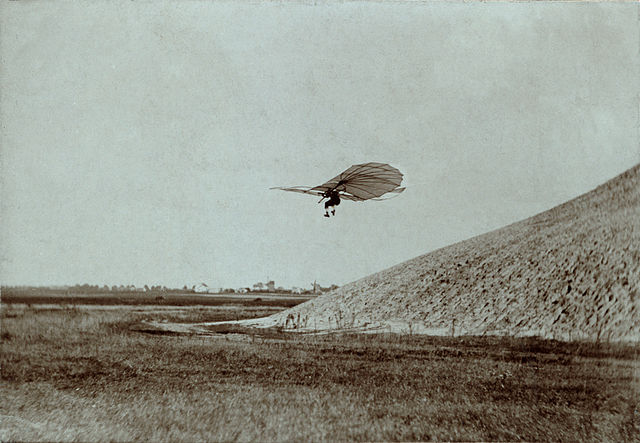It’s a routine thing to hop on a plane to travel somewhere. But of course it wasn’t always that way; somebody had to figure out how to make an airplane. The Wright brothers usually get credit for building the first one that sort of worked. But before they were able to demonstrate a flying machine with an engine, the “flying” part came first, and for that we have Otto Lilienthal, born May 23, 1848 in the Kingdom of Prussia. Lilienthal was the first to build flying gliders. He also founded the world’s first airplane manufacturing company, Maschinenefabrik Otto Lilienthal. They made and sold gliders.
Lilienthal had a brother, Gustav, who he worked closely with throughout his life. They made strap-on wings in grammar school after studying birds, but couldn’t come up with anything that worked. He went on to become a professional design engineer, but was evidently thinking about flying the whole time. He started experimenting with the nature of air and the force it could exert in 1867, and kept careful notes. His first patent, though, was for a machine used in mining.
Lilienthal’s work on wings and heavier-than-air crafts took place near Berlin, Germany. He was a meticulous experimenter and careful engineer, and he even built his own artificial hill for launching his gliders. In 1891, when he was 33, he was trying out a new glider big enough for him to ride when he managed to cover about 25 meters in the air, and then found an updraft strong enough for him to hover, in the air. A photographer was with him, and recorded the moment of the first manned flight. By 1893 he was able to glide for 250 meters.
Lilienthal’s gliders were difficult to control, because unlike modern hang gliders, where the pilot hangs below the wing and steers by shifting their whole body, Lilienthal attached his gliders to his shoulders, so he could only use his legs to change the center of gravity. He made dozens of gliders, and even more models, including monoplanes, biplanes, and a few designs in which the wings flapped like birds. He was looking for a way to apply power to flight, and thought flapping wings might be the answer. Five of his original gliders still exist, in museums.
Lilienthal was awarded 25 patents, and was able to spend time and money on his glider research thanks to his invention of a new steam engine that made him financially independent. He published a book, Birdflight as the Basis of Aviation, in 1889. He made over 2,000 flights, and totalled over five hours in the air by 1896, when he died in a glider crash. Wilbur Wright, who with his brother Orville followed Lilienthal’s work closely, said in 1912:
“Of all the men who attacked the flying problem in the 19th century, Otto Lilienthal was easily the most important. … It is true that attempts at gliding had been made hundreds of years before him, and that in the nineteenth century, Cayley, Spencer, Wenham, Mouillard, and many others were reported to have made feeble attempts to glide, but their failures were so complete that nothing of value resulted..”

Lilienthal in the air in 1895.
